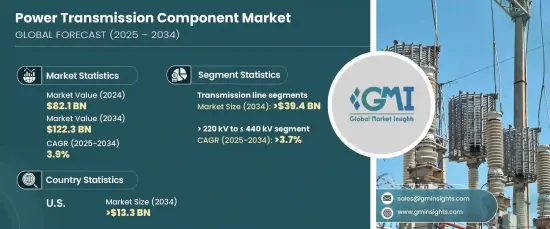PUBLISHER: Global Market Insights Inc. | PRODUCT CODE: 1666674

PUBLISHER: Global Market Insights Inc. | PRODUCT CODE: 1666674
Power Transmission Component Market Opportunity, Growth Drivers, Industry Trend Analysis, and Forecast 2025 - 2034
The Global Power Transmission Component Market reached USD 82.1 billion in 2024 and is projected to grow at a CAGR of 3.9% from 2025 to 2034. This growth is fueled by rising energy demands, the modernization of power grids, and the increasing integration of renewable energy sources. Rapid urbanization and industrialization, particularly in developing nations, are driving the need for efficient and reliable electricity transmission systems. Governments and utilities worldwide are investing in upgrading outdated grid networks to improve efficiency, minimize losses, and enhance resilience.

In terms of components, the transmission line segment is poised to generate USD 39.4 billion by 2034. This growth is driven by the increasing need for reliable and space-efficient power transmission solutions, particularly in industrial applications. Gas-insulated switchgear (GIS) is gaining popularity for its compact structure, high reliability, and ability to perform under challenging conditions. The rise of industrial automation and the widespread adoption of renewable energy propel the deployment of advanced transmission lines integrated with GIS technology.
| Market Scope | |
|---|---|
| Start Year | 2024 |
| Forecast Year | 2025-2034 |
| Start Value | $82.1 Billion |
| Forecast Value | $122.3 Billion |
| CAGR | 3.9% |
By voltage level, the >220 kV to <=440 kV segment is expected to achieve a CAGR of 3.7% during 2025-2034. This range is essential for high-capacity power transmission in heavy industrial and utility applications, such as mining, oil and gas, and large-scale manufacturing. The demand for efficient power systems in these sectors is growing due to the critical need for a reliable and uninterrupted energy supply. Investments in infrastructure upgrades across developed nations and the rapid industrial growth in emerging economies support this segment's expansion.
U.S. power transmission component market is anticipated to generate USD 13.3 billion by 2034. The modernization of aging infrastructure and the increasing demand for efficient energy transmission systems are key drivers. The growing integration of renewable energy sources, such as wind and solar, necessitates advanced switchgear solutions capable of managing fluctuating power loads and ensuring grid stability. Additionally, the push for automation and digitalization within the U.S. industrial sector is boosting demand for smart gas-insulated switchgear equipped with IoT sensors and real-time monitoring features.
As global energy demands and sustainability goals continue to shape the power transmission landscape, advancements in technology and infrastructure development will remain critical to meeting future requirements. The market is set to witness steady growth as it adapts to evolving energy needs and technological innovations.
Table of Contents
Chapter 1 Methodology & Scope
- 1.1 Market definitions
- 1.2 Base estimates & calculations
- 1.3 Forecast calculation
- 1.4 Data sources
- 1.4.1 Primary
- 1.4.2 Secondary
- 1.4.2.1 Paid
- 1.4.2.2 Public
Chapter 2 Executive Summary
- 2.1 Industry synopsis, 2021 - 2034
Chapter 3 Industry Insights
- 3.1 Industry ecosystem analysis
- 3.2 Regulatory landscape
- 3.3 Industry impact forces
- 3.3.1 Growth drivers
- 3.3.2 Industry pitfalls & challenges
- 3.4 Growth potential analysis
- 3.5 Porter's analysis
- 3.5.1 Bargaining power of suppliers
- 3.5.2 Bargaining power of buyers
- 3.5.3 Threat of new entrants
- 3.5.4 Threat of substitutes
- 3.6 PESTEL analysis
Chapter 4 Competitive landscape, 2024
- 4.1 Strategic dashboard
- 4.2 Innovation & sustainability landscape
Chapter 5 Market Size and Forecast, By Component, 2021 – 2034 (USD Million)
- 5.1 Key trends
- 5.2 AC transformer
- 5.3 Circuit breaker
- 5.4 Isolator
- 5.5 Insulator
- 5.6 Arrestor
- 5.7 Transmission line
- 5.8 Transmission tower
- 5.9 Other
Chapter 6 Market Size and Forecast, By Voltage Level, 2021 – 2034 (USD Million)
- 6.1 Key trends
- 6.2 > 132 kV to ≤ 220 kV
- 6.3 > 220 kV to ≤ 440 kV
- 6.4 > 440 kV to ≤ 660 kV
- 6.5 > 660 kV to ≤ 765 kV
- 6.6 > 765 kV
Chapter 7 Market Size and Forecast, By Current Level, 2021 – 2034 (USD Million)
- 7.1 Key trends
- 7.2 HVAC
- 7.3 HVDC
Chapter 8 Market Size and Forecast, By Region, 2021 – 2034 (USD Million)
- 8.1 Key trends
- 8.2 North America
- 8.2.1 U.S.
- 8.2.2 Canada
- 8.2.3 Mexico
- 8.3 Europe
- 8.3.1 UK
- 8.3.2 France
- 8.3.3 Germany
- 8.3.4 Italy
- 8.3.5 Russia
- 8.3.6 Spain
- 8.4 Asia Pacific
- 8.4.1 China
- 8.4.2 Australia
- 8.4.3 India
- 8.4.4 Japan
- 8.4.5 South Korea
- 8.5 Middle East & Africa
- 8.5.1 Saudi Arabia
- 8.5.2 UAE
- 8.5.3 Turkey
- 8.5.4 South Africa
- 8.5.5 Egypt
- 8.6 Latin America
- 8.6.1 Brazil
- 8.6.2 Argentina
Chapter 9 Company Profiles
- 9.1 ABB
- 9.2 Eaton
- 9.3 Fuji Electric
- 9.4 General Electric
- 9.5 Hitachi Energy
- 9.6 Hubbell
- 9.7 Hyosung Heavy Industries
- 9.8 Hyundai Electric
- 9.9 L&T Electrical
- 9.10 Lucy Group
- 9.11 Mitsubishi Electric
- 9.12 Norelco
- 9.13 Powell Industries
- 9.14 Rittal
- 9.15 Schneider Electric
- 9.16 Siemens
- 9.17 START Electrical




